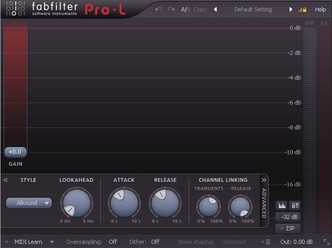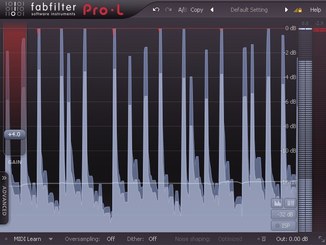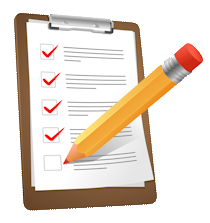FabFilter Pro-L Review
FabFilter Pro-L Review – Solid as a Brick!
Brickwall, that is . . . solid as a brick wall. It seems that we audio engineers are ever striving to achieve “the perfect” blend of punch, dynamics and loudness in our mixes. For many, this is an elusive science requiring a good deal of experience, a proper listening environment, a professional set of near-field monitors, and of course, premium equipment and software.
It’s safe to say that most nearly anyone whom has ever attempted to produce professional, modern recordings has found themselves longing for a mastering-grade brickwall limiter. Pro-L dons a price tag that aptly places it in the pro leagues, and it’s for sure that FabFilter are well known for their audio processing prowess. Still, there are similar products available, and how are we to know if the $229 Pro-L is actually able to get the job done – without making the final product sound as though it were squished under an audio steam roller?
We review it carefully and stay focused on our objective; that’s how!
Mastering.
Oy! It’s very much a skill and art form all its own. If an engineer is suitably supplied with the appropriate tool-kit, he or she has much better odds at achieving professional results. Keep in mind that having the finest tools available cannot compensate for a lack of skill or talent. That being said, neither will utilizing subpar appliances accord an engineer with the degree of quality and functionality necessary to produce major label results. FabFilter strive to produce world-class plug-ins that will empower professional audio engineers to deliver polished results. A reliable, transparent, mastering limiter is a definite must-have in any audio mastering house. Nevertheless, just getting it loud isn’t good enough anymore. A finished project must be able to keep up with modern perceived volume levels while retaining a strong sense of musical dynamics. Back in the middle 90s , an unfortunate audio epidemic exploded on the music scene – it quickly became not-so-affectionately known as the “loudness wars”. In its earliest stages, many of us were impressed with sheer, brute-force limiting. However, as the trend continued to escalate out of proportion, certain pundits said: “Stop! Enough is enough.” The industry matured and we realized that loud for the sake loud wasn’t good enough. We were missing what is most important in professional mixes – dynamics, clarity and tone. Enter FabFilter’s Pro-L. Pro-L is purported to be a highly transparent, powerful mastering limiter. It hosts a tidy sum of industry-leading features while maintaining an extremely fluid workflow. Let’s peer under its hood and find out exactly what this digitally fuel-injected, high octane audio processor is all about.
Installation and Authorization:
Unlike many of their prestigious counterparts, FabFilter do not force customers to authorize their plug-ins via online C/R (Call - Response) or dongle protection mechanisms. Rather, FabFilter utilizes a convenient, personalized license key process. Once a product has been purchased, the customer receives a unique authorization code by email. Said authorization code may then be activated *once* on the FabFilter web site, where a personalized license code will be generated and made available to the customer. Major KUDOS to FabFilter. The downloadable installers serve as both demo and full versions. These are easily unlocked once the product(s) has been paid for and authorized. The unlocking or “authorizing” is accomplished by “pasting” the license key text into the plug-in’s authorization fields. Each authorized item will always be listed in the customer’s “My Account” area of the FabFilter web site. 
The main body of the interface is actually a generous waveform display. Whenever the plug-in is processing an audio signal, the user can see at a glance how the signal is being affected in real time. Uncompressed segments of the audio signal are displayed in blue, while those parts that have been limited are clearly viewed in red. The waveform scrolls smoothly from right to left and makes use of hardware acceleration where available.
Visuals:
Oui, Monsieur, Pro-L discretely shows off an intuitive, easily navigated interface. This plug-in shares the good looks and super simple-to-use interface styling of its FabFilter brethren. Attractive lines, silky smooth controls, finely tuned knobs, good lookin’ appointments, and a first-in-class waveform display – it’s all here in abundance. Comparing FabFilter plug-ins to some of their competitors’ wares is like comparing a Ford Fiesta to a Porche 911. One will get you where you need to go, looks nice and won’t cost you through the nose. The latter gets you there much faster, more comfortably, and is dripping with attractive, visual allure. This discrete, well-designed GUI is a testament of FabFilter’s careful attention to details and focus on workflow fluidity. The user will not be disturbed by quirky nor erratic GUI aberrations. The interface showcases a classy, charcoal-grey background with a hint of reddish/burgundy cast overlaying it. The darkened background makes for immediate, legible contrast with clearly-seen, light-grey text elements.
The left edge of the GUI houses the primary user control – the input gain slider. Its values range from 0dB all the way up to a Nascar passing-gear ratio of +30dB. On the right side you will find a pair of meters: output level and gain reduction, respectively. As one would expect from FabFilter, the continuity between all GUI elements is cohesive and familiar. The output level meter displays in blue increments while the gain reduction is distinguished in red. The metering is smooth and responsive; again this is especially the case on hardware accelerated systems. Throughout my tests, I have become entirely convinced that the metering system lives up to the developer’s claims: “surgically precise!” 
An orderly, uncluttered row of advanced controls are inconspicuously tucked out of view until needed. Clicking on the “Advanced” tab on the lower left side of the GUI expands a tidy panel-strip which comfortably houses knobs for adjusting Lookahead, Attack, Release, Transients, and Channel Linking. Here, you also have a drop down menu where you can select any one of the four available limiting algorithms: Transparent, Punchy, Dynamic and All Round.
Opposite the “Advanced” tab you will notice a small, neat grouping of buttons for enabling/disabling the waveform display and meters. ISP (Inter-sample peaks) detection can be activated and the metering measurement scale can be adjusted.
Eloquent, subtle illumination effects are observed while hovering your mouse cursor over any of the GUI controls. Each of the attractive, well-placed GUI appointments are silken-smooth to adjust with mouse movements. Convenient direct (typing) input is accessible by double-clicking on the buttons (or gain slider). A further degree of convenience is the ability to reset any control back to its default value by holding down the “ctrl” key while left-clicking with your mouse. At dimensions of 640 x 480px, the screen freehold requirements are moderate. However, I actually found myself wishing that the plug-in were size-adjustable to accommodate higher monitor resolutions.
Operations & Control:
Along the top of Pro-L’s interface, the user has easy navigational access to FabFilter’s Fab-u-lous presets management system. The presets are intelligently divided into six categories: Acoustic, Clipping, Dance & Electronica, Pop, Rock and Single Channel. The latter features a nice boutique collection of presets tailored for individual Bass, Drums, Guitar and Vocals tracks. Of course, one may tweak and save customized settings which will then also be listed in the presets menu. A-B comparisons are easily made between presets, and handy-dandy undo/redo functionality is also conveniently at a user’s disposal. For those who don’t necessarily enjoy trudging through lengthy PDF formatted documentation, FabFilter have incorporated a convenient, stream-lined help system. This is realized via a concise help file in tandem with interactive help hints. Hovering your mouse cursor over any GUI element will produce an informative dialogue popup in the upper right corner of the interface. Pro-L is complimented with a fully K-system compliant metering system. The metering is selectable between K-12, 14, and K-20. The output meters can be gauged for 3 scales of operation: the more precise 16dB, a moderate 32dB, and the dynamically ranged 48dB scale. Along the bottom of the interface you will readily find Midi Learn, Oversampling, Dithering, Dithering Options, Global Bypass, and Output controls. Overall, the entire range of user-adjustable controls and GUI functionality is smooth, easy-to-use, and precise. FabFilter plug-ins are an absolute joy to use.
Sound Quality:
Powerful and Transparent! Unless you push this limiter to the zenith, it remains grandly effective and transparent. Even when I increase the input gain to excessive amounts, Pro-L aptly limits the audio WITHOUT causing the music to sound flat and lifeless. In this reviewer’s estimation, Pro-L is capable of dramatically increasing perceived volume levels while simultaneously retaining dynamic range and fidelity. Pro-L earns Olympic points for its muscular, agility to “Make it loud, n’ keep it clear!”
Click to set custom HTML
** This is not a testimonial that I announce lightly; after all, there are many readers who might be basing a prospective purchase on what we, the press community, publish.
Cycling through Pro-L’s four algorithms yields subtle, yet effective changes. This is an appreciable feature for the professional engineer who works with various music types. In most situations, the All Round mode produces above-average results and tends to facilitate the most pronounced perceived volume increases. Of the four, this algorithm is most likely the most program-dependent. Transparency, on the other hand, is favorable for restraining headroom-stealing peaks, but it will allow occasional signal spikes to slip through if pushed too hard. Personally, I found the Transparency algorithm to be well-suited for controlling individual tracks; such as a bass track or drums bus. If you’re looking for a tasty, slightly pronounced “pumping” style of limiting, then the Punchy algo will be sure to tickle your fancy. It continues to minimize distortion, but it can introduce a bit of an edge; especially to electronica and dance tracks. The Dynamic mode seems to be the most adept of the lot at delivering loudness with clarity (emphasis on clarity). This algorithm is finely-tuned to preserve as much transient information as possible, taking it into territory typically dominated by processors in the vein of Slate Digital’s “FG-X”. In many cases, the default non-up sampled settings will produce superb results. That said, engaging 2x or even 4x oversampling yields even cleaner, higher fidelity outcome. FabFilter’s proprietary implementation of linear-phase oversampling is highly effective and does not suffer from ugly “pre-ringing” or “smearing”. Throughout my reviewing process, it seemed that no matter what I piped into Pro-L, the output remained clean and dynamic. My own bench-test findings corroborate the company’s claim that this plug-in is indeed “transparent”.
CPU Consumption:
This agent of audio stealth sits gracefully and gently within your DAW while it is processing at default non-up sampled settings. Any modestly-powered system, built 2010 or after, should be able to run a few instances of this plug-in with relative ease. A busy mix could enlist multiple instances of Pro-L to constrain individual channel peaks without imposing heavy demands on your system’s CPU. Mind you, if oversampling is engaged, the processing demands are obviously increased. Concluding Remarks: Reviewer’s Revival awards 5 Stars to FabFilter for this powerful, transparent limiter. Upon initial consideration, FabFilter plug-ins may seem to occupy a fairly expensive retail space; however, the amazing results the plug-ins produce certainly qualifies their price point. I suspect that any serious engineer (professional or enthusiast) will greatly appreciate this industrial-grade plug-in whenever transparent, high fidelity brickwall limiting is required. One of the “polishing” touches that takes a decent mix up into the Pro category is loudness balanced with GREAT tone and well-defined dynamics. ** NOTE: FabFilter offers a 50% EDUCATIONAL DISCOUNT to qualifying students and teachers.
Brother Charles is a freelance writer, Gospel music artist and minister. Charles had been a professional touring musician during the nineties; working primarily as a lead guitarist in the Canadian country music industry. Brother Charles is also involved with music production and quality home recording.
1 Comment
55 Rocker
7/3/2022 08:04:35 pm
This is one of the best Fabfilter reviews I’ve seen and I agree with your thoughts.I have both Pro L original and Pro L2. Pro L2 is definitely better, but even if I couldn’t afford to upgrade the original version, it can still handle pretty much all my limiting needs and is still ne of the best limiters ever.
Reply
Your comment will be posted after it is approved.
Leave a Reply. |
NO SPAM! IK Multimedia Group Buy
FX Pick & Mix Group Buy - up to 16 for the price of 1
Will You Help?Web hosting is getting more and more expensive all the time, and Reviewer's Revival is NOT funded nor supported by any commercial enterprise or business. A donation of any amount is greatly appreciated. Even $2 or $3 for a coffee - every little bit helps. Thanks very much.
Legal BlurbAll of the articles published on Reviewer's Revival are undertaken to be purely objective, impartial reviews. Reviewer's Revival is not owned, funded-by, nor hired by any company or individual. Reviewer's Revival is the sole property of, and solely under the discretion and direction of Brother Charles. |






 15% OFF Summer Sale!
15% OFF Summer Sale!
 RSS Feed
RSS Feed

